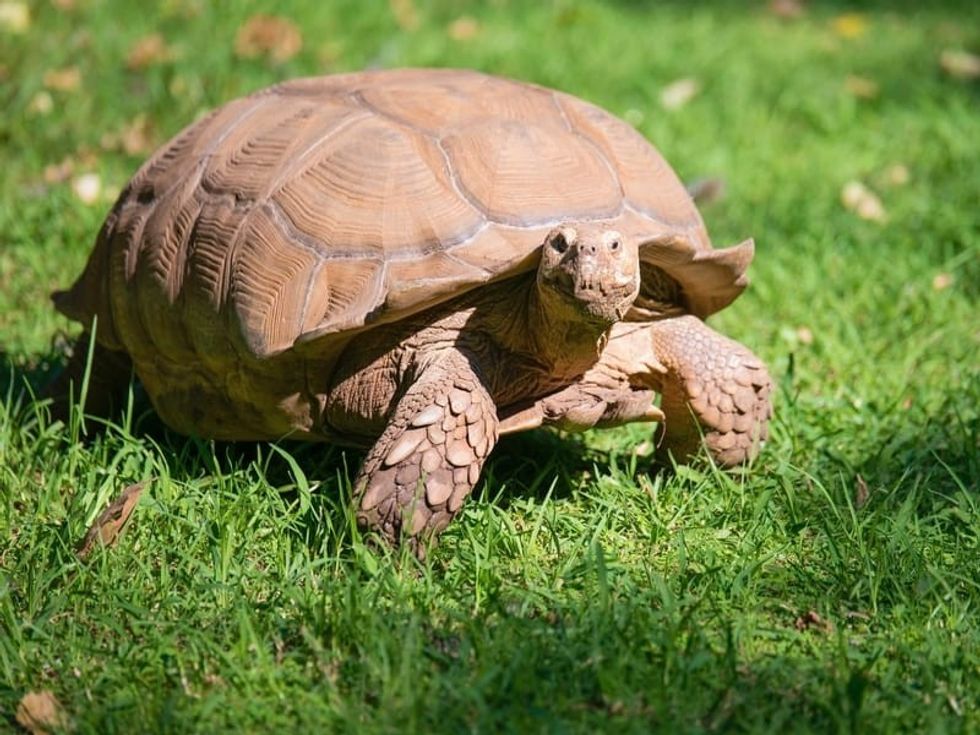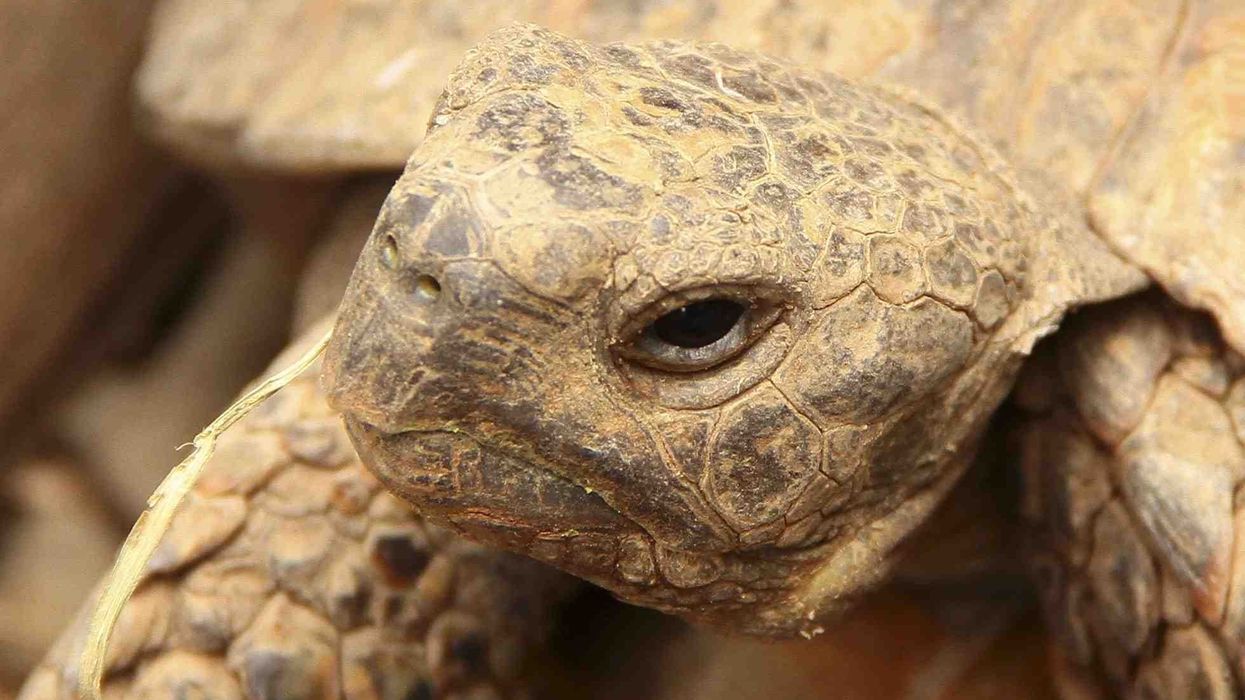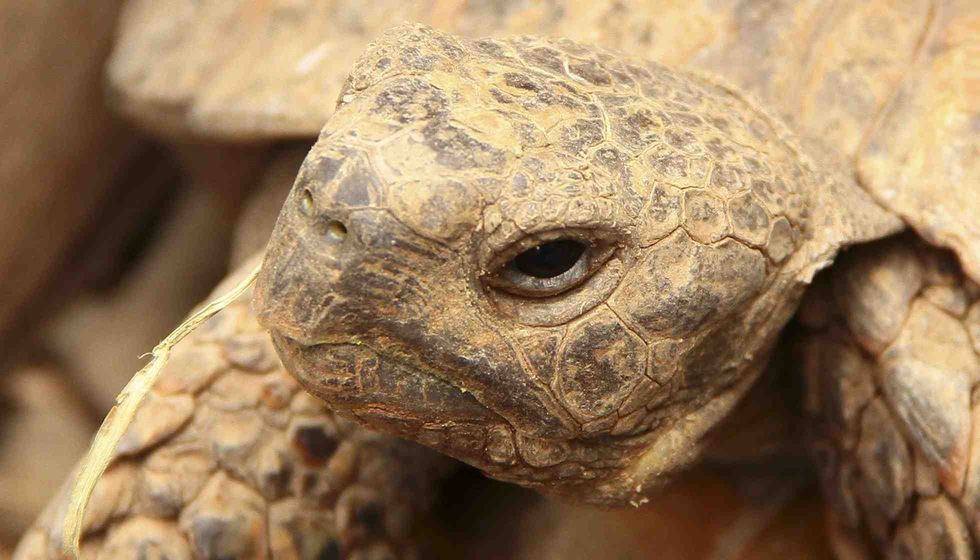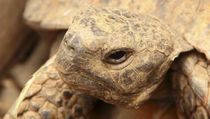Fun Marginated Tortoise Facts For Kids

Are you fascinated by reptiles? Then there is the amazing marginated tortoise! Marginated tortoises (Testudo marginata) are native to Greece, Italy, and Albania.
The shell of this tortoise is black with yellow splotches on the carapace. The carapace can look very charming and they are usually so tame and calm that they have become a favorite as pets of many people. They need enough heat and sun in the winter.
They like to bask in the sun as well. Humidity should be balanced in their cage, it can cause respiratory problems.
Marginated tortoise food should include foods of a plant-based diet, like spring greens, prickly pear, and some fruits. To keep the tortoises healthy, enacting their natural habitat requirements is very important. They can grow very big.
They are one of the largest tortoises in Europe. They also live for a long time. Some even live for about 100 years!
Read on to know more about the marginated tortoise, and if you like this article then check out radiated tortoise facts and African spurred tortoise facts.
Marginated Tortoise Interesting Facts
What type of animal is a Marginated tortoise?
The marginated tortoise is a kind of tortoise. It is one of the largest tortoises in Europe.
What class of animal does a marginated tortoise belong to?
Marginated tortoises belong to the Reptilia class of animals.
How many marginated tortoises are there in the world?
The exact population of these tortoises is not known. Thus they have a very low population density.
Although, this data was found after very little research as the natural habitat of these tortoises couldn't be reached. Getting into the living space of these tortoises is hard, and it is also one of the reasons why their population cannot be calculated.
Some other species of tortoises include the leopard tortoise, the Russian tortoise, and the African spurred tortoise.
Where does a marginated tortoise live?
The species is mainly native to Italy, Greece, and Albania. In Greece, the tortoise can be seen in southern, central, and northwestern parts of the country.
It can be seen on some islands and in the southernmost range of Albania. Some introduced marginated tortoises can be found in southwestern, as well as northeastern parts of Sardinia and the island of Crete. Some uncertain reports dictate that a few marginated tortoises were also introduced in the western part of Anatolia.
What is a marginated tortoise's habitat?
The marginated tortoise's habitat is usually mountainous regions. They can be found at an elevated level of up to 4265 ft (1300 m), but most of these tortoises prefer to stay below 2625 ft (800 m).
They prefer to live in a dry and hot climatic area as well. The tortoises can be seen living in thorny scrubs, vegetated areas, damp areas, agricultural fields, visible rocky bedrocks, and Macchia and Phrygana scrubs.
Who do marginated tortoises live with?
Marginated tortoises are widely kept as pets, so they are known to be able to live with humans. They can also live well with others of their species in groups when they are kept in captivity. They can be seen competing with each other at times, but that shouldn't pose a problem as they are known to do that.
How long does a marginated tortoise live?
On average, a marginated tortoise's lifespan is 20 years at the very least. Some records say that they can even live for 100 years or so.
How do they reproduce?
The marginated tortoises hibernate during the winter and they get ready to breed once they wake up from hibernation. The males are known to follow the females.
As the courtship ritual, the males are known to encircle the females and nibble on the limbs of the females. During the copulation, the male makes a sobbing noise, which is usually deep in tone and length.
The female can be seen bobbing her head from right to left with the rhythm of the cry of the male. After copulation, the female will look for a place to lay her eggs.
When she likes a place, she will dig a hole and will lay about 15 eggs at a time.
Some tortoises that are larger, can be seen breeding three times in one breeding season. The females lay the eggs around the time of late May to late June.
Once she has laid her eggs, she will bury them in the hole, and leave the eggs to incubate in there. The eggs are incubated by the temperature and pressure of the nest.
The incubation period varies and can reach up to about 100 days, but the eggs start to hatch after 60 days. Many times it has been seen that the hatchlings stay under the ground and there, the tortoises grow for the next two weeks or so, and then they come out.
What is their conservation status?
The conservation status of the marginated tortoise, according to the International Union for Conservation of Nature, is listed as of Least Concern. As to conserve the tortoises, they are included in the Greek domestic legislation and the CITES Appendix II.
Marginated Tortoise Fun Facts
What do marginated tortoises look like?

The species of marginated tortoise is the largest among all the species of the genus Testudo. These tortoises have an oblong, dome-shaped carapace.
The posterior scutes on the shell are flared and resemble a saw. The front side of the limbs of this reptile has many large scales. The carapace of the tortoises is usually black with a few yellow highlights on it.
The lower part of the shell is paler in comparison. It has a few triangular markings, facing the rear part of the tortoise on the lower part of the shell.
How cute are they?
These large tortoises can look extremely cute, owing to their beautiful colors. They have yellow splotches on their black shell, which can be quite beautiful to look at.
They are also rather calm and friendly. They will rarely show any aggression or anger, which only adds to their charm. These are also a few of the reasons why they are a very popular choice as pets.
How do they communicate?
Tortoises use various means to communicate. They use visual cues, vocal cues, touch, and smell to communicate with each other.
During the courtship ritual, the males nibble at the limbs of the females to let her know of his availability. The males also let out a cry during this time to which the females swing their heads in rhythm. Sometimes they also use their limbs to get an understanding of their surroundings.
How big is a marginated tortoise?
Adult marginated tortoises can grow up to 10-15.7 in (25.4-39.9 cm) in length. These tortoises are about four times smaller in length than the Aldabra giant tortoise, one of the largest land tortoises in the wild world. Aldabra giant tortoises can grow up to be 3-4 ft (91.4-122 cm) in length.
How fast can a marginated tortoise move?
The exact speed at which the marginated tortoise moves is not known. However, as we know that tortoises move at a pretty slow rate, we can assume that the marginated tortoise would move at a slow pace as well.
How much does a marginated tortoise weigh?
The marginated tortoise is large-sized. An adult can weigh up to 11 lb (5 kg). The weight of the Aldabra giant tortoise can be 50 times more than that of a marginated tortoise. The Aldabra giant tortoise can weigh up to 550 lb (249.5 kg).
What are the male and female names of the species?
The males and the females of the species don't have any specific names, but an interesting fact about them is that a group of tortoises is called a creep.
What would you call a baby marginated tortoise?
A baby tortoise is called a hatchling.
What do they eat?
Marginated tortoises are herbivorous animals. Their diet is known to be plant-based. In the wild, they eat flowers, leaves, plants, and fruits.
The majority of the marginated tortoise diet should include green plants and leaves. The rest can be fruits. Plants like sage, prickly pear, or globemallow are good for them.
The tortoises can eat tough food; hence, chopping up the fruits won't be necessary. If you are giving your pet commercial tortoise food, then make sure that it's high-quality food. You can also give them leafy greens, spring greens, and bell peppers.
Are they friendly?
These tortoises are known to be very calm. They have been known to be friendly toward humans even in captivity, as well. They rarely show any anger and they only get aggressive when they feel threatened.
Would they make a good pet?
They make excellent pets. Many people have taken them home to keep as pets.
They live for a long time and can even live longer if proper care is provided to them in captivity. Even though they don't require very high maintenance, more than normal care should be taken for these animals. As they are fun to live with it will be worth it to invest in them.
Did you know...
Marginated tortoise size grows at a high rate. The young ones grow at a rate of 3.5-17.6 oz (100-500 g) per year. The growth occurs at this rate till they are 20 years of age. After this age, they start to grow at a normal rate.
There are two subspecies of marginated tortoise - the Greek marginated tortoise (Testudo marginata marginata) and the Sardinian marginated tortoise (Testudo marginata sarda). The population of the Sardinian marginated tortoise (Testudo marginata sarda) is endemic to Sardinia.
A marginated tortoise costs about $200-450 USD.
What is the average speed for the marginated tortoise?
The average speed of the marginated tortoise is not known. They are known to be active, and even though they move slowly, they move at a moderate speed for a tortoise.
Do Marginated tortoises bite?
Marginated tortoises bite others of their species. Mainly the males bite the females when the breeding season occurs.
The tortoises are also known to fight with each other, but it's pretty normal for them. There have not been any records of this animal biting any human, but it's better to be gentle with them. They might become aggressive and they are also prone to head-banging when they feel threatened in some way.
Marginated Tortoise Care
Marginated tortoises don't need very high maintenance, but some conditions need to be met to keep them healthy and happy. When you are bringing a baby tortoise home, you can keep it in a medium-sized container, and then change the size of the container gradually.
Also, when they are in the house, the room temperature of the indoor enclosure should be 78.8-86 F (26-30 C).
The tortoises like basking in the sun to keep the balance of their body temperature. The temperature of the area should be about 85-90 F (30-33 C).
The body temperature of the tortoises is almost normal and they won't need artificial heat, but the temperature should not fall lower than 64.4 F (18 C). Artificial UVB lighting in the cage works wonders with them.
The substrate inside should be at least 2 in (5 cm) deep, as the tortoises require burrowing.
During the summer, they can be taken outside to bask in the heat of the sun and roam around. However, the outdoor enclosure should be fenced or somehow protected, so that predators can't reach the tortoises.
Here at Kidadl, we have carefully created lots of interesting family-friendly animal facts for everyone to discover! Learn more about some other reptiles including gopher tortoise facts and spider tortoise facts.
You can even occupy yourself at home by coloring in one of our free printable marginated tortoises face coloring pages.
We Want Your Photos!
More for You
Bachelor of Arts specializing in Journalism and Mass Communication, Postgraduate Diploma in Sports Management

Moumita DuttaBachelor of Arts specializing in Journalism and Mass Communication, Postgraduate Diploma in Sports Management
A content writer and editor with a passion for sports, Moumita has honed her skills in producing compelling match reports and stories about sporting heroes. She holds a degree in Journalism and Mass Communication from the Indian Institute of Social Welfare and Business Management, Calcutta University, alongside a postgraduate diploma in Sports Management.
Bachelor of Science specializing in Systems Engineering

Oluwapelumi IwayemiBachelor of Science specializing in Systems Engineering
Iwayemi is a creative content writer and editor studying for a Bachelor of Science specializing in Systems Engineering from the University of Lagos. He is skilled in research and has experience writing and editing content for different organizations.
Disclaimer
1) Kidadl is independent and to make our service free to you the reader we are supported by advertising. We hope you love our recommendations for products and services! What we suggest is selected independently by the Kidadl team. If you purchase using the Buy Now button we may earn a small commission. This does not influence our choices. Prices are correct and items are available at the time the article was published but we cannot guarantee that on the time of reading. Please note that Kidadl is a participant in the Amazon Services LLC Associates Program, an affiliate advertising program designed to provide a means for sites to earn advertising fees by advertising and linking to Amazon. We also link to other websites, but are not responsible for their content.
2) At Kidadl, we strive to recommend the very best activities and events. We will always aim to give you accurate information at the date of publication - however, information does change, so it’s important you do your own research, double-check and make the decision that is right for your family. We recognise that not all activities and ideas are appropriate for all children and families or in all circumstances. Our recommended activities are based on age but these are a guide. We recommend that these ideas are used as inspiration, that ideas are undertaken with appropriate adult supervision, and that each adult uses their own discretion and knowledge of their children to consider the safety and suitability. Kidadl cannot accept liability for the execution of these ideas, and parental supervision is advised at all times, as safety is paramount. Anyone using the information provided by Kidadl does so at their own risk and we can not accept liability if things go wrong.
3) Because we are an educational resource, we have quotes and facts about a range of historical and modern figures. We do not endorse the actions of or rhetoric of all the people included in these collections, but we think they are important for growing minds to learn about under the guidance of parents or guardians.







